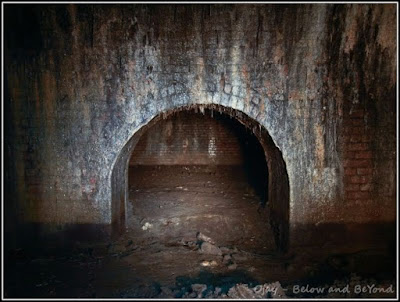The Cumberland Street site.
The Deansgate Tunnel has never been fully documented or surveyed and evidence of its existance and extent is based upon rare glimpses and hearsay. Its age is unknown but it is assumed to be between 200 and 300 years old. Its purpose is unknown. There are even suggestions that it might be Roman in origin.
The tunnel is believed to start near the northern end of Deansgate, close to the Cathedral and to follow the line of the road southwards as far as Knott Mill. Here the tunnel turns westwards towards Old Trafford.
At St. Mary's Gate was Albert Wagstaff's Piano Shop. A large glass walled residential building, One Deansgate now occupies the site. From Wagstaff's, two flights of stairs led to the tunnel which was used for storage.
Farther along Deansgate at 66, was the Old Deanery from which the road takes its name. J. Lindley recalled that in the wine cellars was a small door leading to a passage followed by 10 or 12 stone steps. A left turn took one towards Wagstaff's and the Cathedral.
The Old Deanery. A watercolour by William Sharpe Ogden 1897.
Silver Street, Hulme is now known as Silvercroft Street. Here the tunnel could be entered through a door beneath the houses.
Silver Street
When excavating the railway at Cornbrook Junction, workmen discovered what was believed to be part of the Deansgate Tunnel. The south-western extremity as far as is known was at Trafford Hall Lodge. Here a shaft was found and descending a rope ladder led to the tunnel.
There is just one contemporary account by an urban explorer who calls himself "Ojay" who managed to access the tunnel ten years ago, through a construction site. He describes a filthy, freezing cold place, 20 metres below ground with numerous stalactites and stalagmites. A number of interconnecting side tunnels were bricked up or backfilled. He found the main tunnel bricked up with an appearance of some age. Ojay's photographs give an impression of the scale. A height of four metres can be measured by counting the number of brick courses. The width must be at least six metres.
The Deansgate tunnel should not be confused with that linking the two parts of Kendal Milne's Department Store. The original store on the east side of Deansgate was completed in 1873 and is now occupied by Waterstones bookshop. A tunnel beneath the street opened in 1920 and gave access to the main building, the reconstructionof which was completed in 1940. The tunnel still exists and is used for storage. A further subway beneath Southgate opened in 1939 and took shoppers to part of the menswear department known as "The Annexe". It was reinforced during the war and served as an air raid shelter.








going down tomorrow
ReplyDeleteDO NOT DO IT, THEIR IS NEW ENTITYS DOWN THERE
Delete